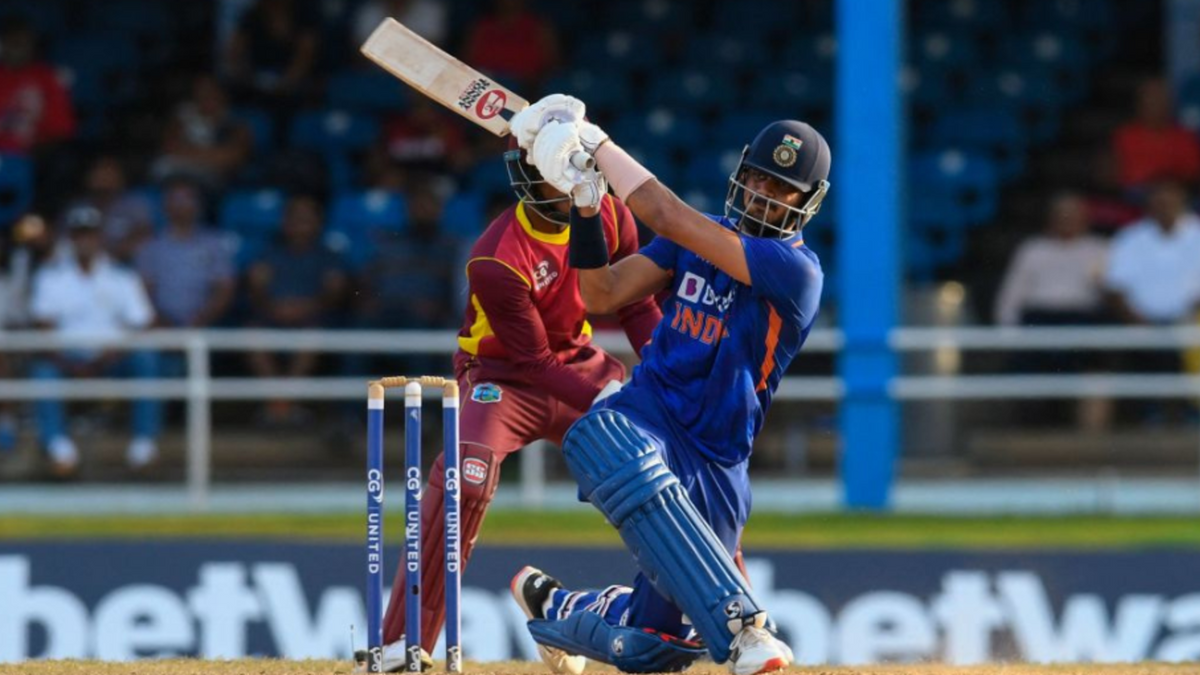
With an unbeaten 64 off 35 balls, Axar Patel delivered a series-sealing punch in the second ODI against West Indies, finally showing that he is more than just a fill-in for Ravindra Jadeja, writes Sarah Waris.
For the longest time, Axar Patel has been dubbed as a bowling all-rounder: the second half of that term, though, hasn’t had a convincing presence in international cricket. While his skills as a slow left-arm orthodox bowler are widely acclaimed – just ask the England Test team from last season – his batting had left much to be desired, especially in white-ball cricket. Before the series against the Windies, Axar averaged a paltry 12.92 with the bat in ODIs, along with a T20I average of 16.83.
Not many would have realised, but Axar’s return to the one-day setup came after a gap of five years. Jadeja’s last-minute injury ahead of the Caribbean tour came as a big jolt to India, already without their batting superstars Rohit Sharma, Virat Kohli, Rishabh Pant, KL Rahul and Hardik Pandya. With Shardul Thakur – whose batting graph has gone up over the years – and Axar the only two “all-rounders” available in the squad, they were expected to slot in at No.7 and 8. Shardul had batted only 11 innings prior to the series in 50-over cricket, crossing 30 on two occasions, while Axar’s previous high in 20 innings was 38, since his debut in 2014.
India’s first-choice left-arm spinner, Jadeja offers a reliable option with the willow, his batting having grown exponentially over the years. Last year, the Chennai Super Kings player averaged 55.75 in ODIs – which reduces to, but still stands at a strong – 36 this year. With none of India’s top-five doubling up as a bowler. Jadeja’s presence in the XI, even without Hardik, gave the team more cushion, allowing the specialist batters the luxury of having an off day, whilst also having room for an extra bowler.
His pull-out, though, left Axar and Thakur as finishers in the side, an arduous task asked of two players whose primary speciality will always remain bowling. It also piled on the pressure on the top and middle-order, who had to get the job done and not just lay the foundation.
That India were in a spot of bother when they were reduced to 205-5 chasing 312 in the second ODI is an understatement. Shubman Gill, Shreyas Iyer and Sanju Samson had all departed with the job not quite done, leaving the visitors needing another 107 runs from 68 balls. Deepak Hooda was already at the crease with Axar, Thakur, and the bowlers Avesh Khan, Mohammed Siraj and Yuzvendra Chahal to follow. What followed was pure carnage.
Batting at No.7, Axar played out one of his best rescue acts, batting fearlessly against both pace and spin, and taking the game to the opposition. He smashed his first six off the eighth ball that he faced, pulling the ball over deep with perfect timing. Another maximum followed three balls later as he powered a Romario Shepherd full-length ball over long-off.
The lack of batting depth, however, meant that India fast succumbed to 280-7 with three bowlers up next. The burden was solely on Axar, who continued getting the better of the bowlers, reaching his fifty off 27 balls. He got under tossed-up balls, opened the face of the bat against the shorter deliveries and even hit a beautiful six straight down the ground off Alzarri Joseph to display his power. The calculation and acceleration were all traits of a dependable finisher.
As it neared 4am in India, Axar Patel’s career saw a new dawn as well. His last-over six to hand India what had once seemed an improbable win further gave an indication of the strides he has been making in the batting department. The transformation hasn’t been overnight: in IPL 2022, the Delhi Capitals player had scored 182 runs in 13 matches with six not-outs, at an average of 45.50 and a strike rate of nearing 152 – the best that he had recorded in any season of the T20 league.
Axar’s showing at Port of Spain also helped him move up the pecking order ahead of other spin all-rounders such as Krunal Pandya and Washington Sundar. The former has been inconsistent with the ball while the latter has been struggling to stay fit for long durations. Axar’s left-arm bowling also lends variety to the Indian attack when Chahal is in operation, just like Jadeja does.
It’s just the start: Jadeja, too, started off more as a bowler, before really finding his identity with the bat. For Axar, it could be a start in getting out of the shadows and becoming more consistent in both departments. So far, he’s only shown shades of potential: if his batting, in particular, can improve further, India would not fret every time Jadeja, their premier match-winner, isn’t available. With workloads being managed better, chances would only open up further for Axar.








